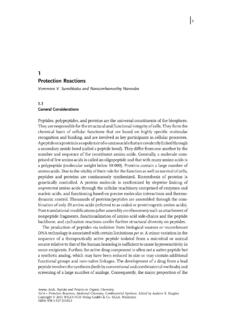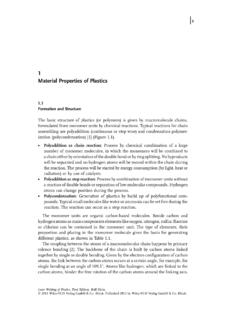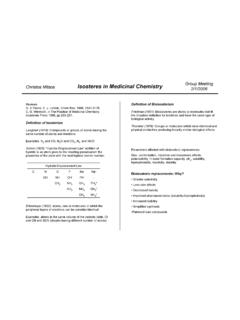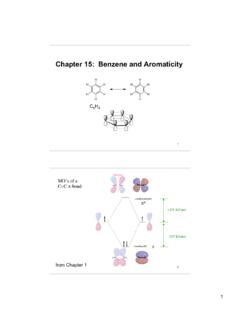Transcription of 1 Heterocyclic Compounds: An Introduction - Wiley-VCH
1 J1. 1. Heterocyclic Compounds: An Introduction Julio Alv arez-Builla and Jos e Barluenga Heterocyclic Compounds: An Introduction The IUPAC Gold Book describes Heterocyclic compounds as: Cyclic compounds having as ring members atoms of at least two different elements, quinoline, 1,2-thiazole, bicyclo[ ]tetrasiloxane [1]. Usually they are indicated as counterparts of carbocyclic compounds, which have only ring atoms from the same element. Another classical reference book, the Encyclopaedia Britannica, describes a Heterocyclic compound , also called a heterocycle, as: Any of a class of organic compounds whose molecules contain one or more rings of atoms with at least one atom (the heteroatom) being an element other than carbon, most frequently oxygen, nitrogen, or sulfur [2].
2 Although Heterocyclic compounds may be inorganic, most contain within the ring structure at least one atom of carbon, and one or more elements such as sulfur, oxygen, or nitrogen [3]. Since non-carbons are usually considered to have replaced carbon atoms, they are called heteroatoms. The structures may consist of either aromatic or non-aromatic rings. Heterocyclic chemistry is the branch of chemistry dealing with the synthesis, properties, and applications of heterocycles. Heterocyclic derivatives, seen as a group, can be divided into two broad areas: aromatic and non-aromatic. In Figure , ve-membered rings are shown in the rst row, and the derivative 1 corresponds to the aromatic derivative, furan, while tetrahydrofuran (2), dihydrofuran-2-one (3), and dihydrofuran-2,5-dione (4) are not aromatic, and their reactivity would be not unlike that expected of an ether, an ester, or Modern Heterocyclic Chemistry, First Edition.
3 Edited by Julio Alvarez-Builla, Juan Jose Vaquero, and Jos Barluenga. 2011 Wiley-VCH Verlag GmbH & Co. KGaA. Published 2011 by Wiley-VCH Verlag GmbH & Co. KGaA. j 1 heterocyclic compounds : An Introduction 2. O O O O O O O. 1 2 3 4. N N N O N. H H H. 5 6 7 8. Figure Examples of Heterocyclic compounds. a carboxylic anhydride, respectively. The second row shows six-membered rings, initially in an aromatic form as pyridine (5), while piperidine (6), piperidin-2-one (7), and 1,2,3,4-tetrahydropyridine (8) are not aromatic; their reactivity would not be very different from that expected of an amine, amide, or enamine, respectively. In general, the reactivity of aromatic heterocycles, which is a combination of that expected from an aromatic system combined with the in uence of the heteroatoms involved, is usually more complex, while the reactivity of the non-aromatic systems is not too different from the usual non-cyclic derivatives.
4 Thus, most books on Heterocyclic chemistry are mainly devoted to the reactivity of aromatic compounds. Tables indicate models of the Heterocyclic derivatives described in these volumes. Table shows simple Heterocyclic systems of three or four members. In this case, the literature examples are mainly non-aromatic, as indicated in the table, and the expected reactivity is always related to the ring strain present in all of them, which produces a release of energy when they are opened to give aliphatic products. Table Main three- and four-membered heterocycles. Ring size Heteroatom N O S Other N O S. 3 H. Aziridine Oxirane Thiirane NH O NH. N O O. H. Diaziridine Dioxirane Oxaziridine P. 4 NH O S Se R. Azetidine Oxetane Thietane Seletane Phosphetane Heterocyclic Compounds: An Introduction j3.
5 Table Main five-membered heterocycles. Ring size Heteroatom N Benzo O Benzo S. 5 N N O S. H H O. Pyrrole Furan Thiophene Indole Benzofuran N N N. 5 N O S. H. Pyrazole Isoxazole Isothiazole N N N. N O S. H. Imidazole Oxazole Thiazole N N. N N N N N N N N. O O S S. N N. N N N N N N N. N. H H N N. O O S S. Triazoles Oxadiazoles Thiadazoles N N. N. N. H. Tetrazole Table indicates ve-membered Heterocyclic systems, such as pyrrole, furan, their benzo derivatives, and thiophene, and a set of heterocycles with more than one heteroatom, as 1,2-azoles, 1,3-azoles, triazoles, oxa- and thiadiazoles, and tetrazole. Table shows six-membered rings, namely, pyridine, its benzo derivatives quinoline and isoquinoline, the pyrilium cation, and, as in Table , other common heterocycles with more than one heteroatom, such as diazines, triazines, and tetrazines.
6 Finally, Table shows the simplest seven-membered ring, that is, azepine and its benzo derivative, as well as examples of the nitrogen bridgehead bicyclic systems, pyrrolizine, indolizines, and quinolizinium cation. Other additional chapters have been included with special systems relevant from different points of view: 2-azetidinones or b-lactams, benzodiazepines, and two general chapters on new materials based on Heterocyclic systems and solid phase and combinatorial chemistry related to Heterocyclic derivatives. j 1 heterocyclic compounds : An Introduction 4. Table Main six-membered heterocycles. Ring size N Benzo O. N. Quinoline +. 6. N O. Pyridine Pyrilium N. Isoquinoline N. N. N. N N N. Diazines Pyridazine Pyrimidine Pyrazine N. N N N. N N. N N N. Triazines N N.
7 NN N N. N N N. N N N. Tetrazines Table Other simple heterocycles. Ring size Heteroatom N Benzo 7 N N. H H. Azepine Benzoazepine +. 5-5, 5-6, 6-6 N N N. Pyrroline Indolizine Quinolizinium Structure and Reactivity of Aromatic Five-Membered Systems j5. Structure and Reactivity of Aromatic Five-Membered Systems As is indicated in most handbooks of Heterocyclic chemistry [3, 4], a pictorial valence bond resonance description is used in most chapters, as a simple way to rationalize the reactivity of the most important aromatic heterocycles. Two examples are described in detail as representative of most of the aromatic rings considered: pyrrole as a model of the p-excessive rings, and pyridine as a model of the p-de cient ones. Pyrrole has a structure that is isoelectronic with the cyclopentadienyl anion, but is electrically neutral, having a nitrogen atom with a pair of electrons, which is part of the aromatic sextet, and its resonance hybrid can be represented as a combination of main forms I V (Scheme ), one without charge, and the others with charge separation.
8 As expected, not all forms contribute equally to the structure of the pyrrole, with the order of importance being I > III, IV > II, V, that is, the major contribution is produced by the non-charged form, and, of the charged ones, those in which the nitrogen is using its lone pair of electrons. As a combination of all forms, structure 9 indicates how the heteroatom bears a partial positive charge, while the carbon positions show an increase in electronic density, compared with the typical aromatic system, benzene. Thus, a p-excessive system such as pyrrole would be easily attacked by electrophiles and not by nucleophiles. - - N. + - + + - +. N N N N. H H H H H. I II III IV V.. N. +. H. 9. Scheme Resonance hybrids of pyrrole. Scheme indicates how the attack of an electrophile usually proceeds.
9 The major isomer 13 is formed through intermediates 10 11 12, of which the intermediate 10. contributes most to the stabilization of the intermediate. Alternatively, a minor isomer 16 is produced through the less stable intermediates 14 and 15. Alternatively, Scheme shows the attack of a nucleophile on pyrrole. Interme- diate 17 is not stabilized, and the lone pair of electrons on the heteroatom does not contribute to the progress of the process. The only process that usually can be detected is deprotonation of the N H bond to generate the pyrrolate (18), which can be used to make a bond with a suitable electrophile ( , an alkyl halide) to produce the N-substituted pyrrole 19. j 1 heterocyclic compounds : An Introduction 6. +. -H+. + E + E E. N N N N E. H H H H H H.
10 11 H. 10 12 13. E+ E E E. N H H. H 9 -H+. + +. N N N. H H H 16. 14 15. Minor isomer Scheme Electrophilic attack on pyrrole. _. No stabilization N Nu H H. 17. _. Nu N. H E+. 9. N N. 18 NuH 19. E. Scheme Attack on pyrrole by nucleophiles. This behavior can be extended with small differences to other p-excessive heterocycles, with the limit due to the existence or not of a N H bond at position 1. In the case of rings like thiazole or isoxazole, the lack of the acidic bond makes the process 9 18 19 impossible. Attack by radicals or complex organometallic reagents are more complex and are discussed in every chapter. Structure and Reactivity of Aromatic Six-Membered Systems The structure of pyridine is analogous to that of benzene, with one of the carbons replaced by a nitrogen atom.


















